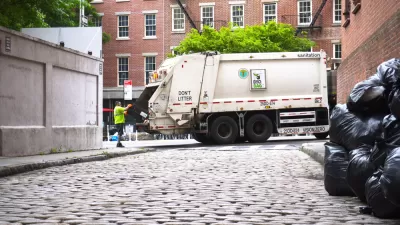Urban planners can play a role in ensuring the best possible waste management practices are implemented whenever possible.

Waste management is one of the most daunting challenges facing modern cities. The United States produced 262.4 million tons of municipal solid waste in 2015, recycling only about 67.8 million tons of that total, composting 23.4 million tons, and burning 33.57 million tons for energy. That leaves about 137.7 million tons of solid waste to collect in landfills over the course of the year.
The massive amount of waste created by households and businesses poses a significant planning challenge. City leaders have to figure out how to collect, transport, sort, and ultimately dispose of trash—whether that involves a landfill, recycling plant, combustion facility, or some other solution.
Doing so requires collaboration between a vast array of public and private sector leaders and institutions, including city planners. For this reason, it's crucial that planners have an understanding of waste management practices. This knowledge can help them notice where and how waste management and city planning intersect and integrate these insights into their work. Here are some of the best practices planners should be aware of.
Proper Waste Facility Siting
The siting of waste management facilities impacts the surrounding communities' health, economic success and quality of life. Landfills produce unpleasant smells and reduce the livability and property values in the areas near where they're located. They can also attract insects and vermin that can spread disease.
For these reasons, it's crucial that landfills be cited in locations where they have minimal impact on the surrounding communities. They must be placed a safe distance away from residential areas, and their need to be protections in place to reduce negative impacts on those that live closest to them.
Historically, environmental risks such as landfills have disproportionally impacted low-income and minority communities. This makes the siting of landfills an issue of economic and environmental justice.
Planners can play a role, along with waste management professionals, in ensuring the safe and equitable siting of waste management facilities.
Make Participation Convenient
Making participation in a waste management program easy and convenient will increase the likelihood of the initiative succeeding. Providing shared recycling bins outside multi-unit dwellings, for example, improves the likelihood that residents will recycle. Providing guidance on best building practices for the location of recycling and trash bins can also help with this.
Providing recycling bins is a relatively simple initiative. Some cities around the world are starting to implement more complex, high-tech solutions that make it easy for citizens to participate in waste management programs.
One example is the Third Zone Automated Waste Collection Plant in Songdo, South Korea. In Songdo, all the trash goes into underground piping that connects to every office and apartment building. This system eliminates the need for outdoor trash cans and garbage trucks. Once in the underground facility, the system automatically sorts and then recycles, burns, or buries the waste. The city requires only seven workers for all its waste management.
Think of Waste as a Potential Resource
Instead of treating waste as a problem, it could be treated as an opportunity. Recovering materials from waste streams through recycling can potentially generate revenue. The town of Capannori, Italy, for example, instituted a zero-waste program in 1997. The program is now self-sufficient financially and even makes money by selling recycled materials.
Waste can also be a useful resource for energy production, either through incineration or harnessing methane gas from biodegradable waste. According to the U.S. Department of Energy, the typical waste-to-energy facility produces about 550 kilowatt hours (kWh) of energy and earns between $20 and $30 per each ton of waste.
Collaboration Is Key
Public-private partnerships can be vital to success in waste management. Local governments and city planners should work with private trash and recycling companies to create programs for optimum results. Making sure every party is on the same page can improve the likelihood of success.
It's also essential to ensure any private or informal recycling companies are complying with relevant environmental and safety standards. Open communication with these companies can help increase transparency in the recycling process. The city government of Portland, Ore., for instance, works with more than 40 private trash and recycling haulers to reduce landfill use.
Collaboration between the government and these private companies has been crucial to the city's success in preventing 70 percent of its waste from ending up in landfills.
Be Open to New Ideas
Today, cities around the world are instituting innovative, unique, and high-tech ideas to improve their trash management. Taking advantage of new technologies and novel ideas can help take a city's waste management to the next level. The city of Songdo is one example. Another is Rotterdam in the Netherlands, which uses digital sensors to detect when paper and cardboard waste bins are almost full. That way, they can be emptied at optimal times.
It's important that waste management professionals, city planners and other stakeholders be open to these new ideas, and test and enable new technologies and programs whenever possible.
Waste management is a challenge for cities, but it's also an opportunity. Lots of different groups and individuals can help improve a city's waste management.
City planners are among those groups. By supporting responsible, efficient and economic waste management practices, city planners can reduce waste and keep their cities cleaner.

Alabama: Trump Terminates Settlements for Black Communities Harmed By Raw Sewage
Trump deemed the landmark civil rights agreement “illegal DEI and environmental justice policy.”

Planetizen Federal Action Tracker
A weekly monitor of how Trump’s orders and actions are impacting planners and planning in America.

The 120 Year Old Tiny Home Villages That Sheltered San Francisco’s Earthquake Refugees
More than a century ago, San Francisco mobilized to house thousands of residents displaced by the 1906 earthquake. Could their strategy offer a model for the present?

Opinion: California’s SB 79 Would Improve Housing Affordability and Transit Access
A proposed bill would legalize transit-oriented development statewide.

Record Temperatures Prompt Push for Environmental Justice Bills
Nevada legislators are proposing laws that would mandate heat mitigation measures to protect residents from the impacts of extreme heat.

Downtown Pittsburgh Set to Gain 1,300 New Housing Units
Pittsburgh’s office buildings, many of which date back to the early 20th century, are prime candidates for conversion to housing.
Urban Design for Planners 1: Software Tools
This six-course series explores essential urban design concepts using open source software and equips planners with the tools they need to participate fully in the urban design process.
Planning for Universal Design
Learn the tools for implementing Universal Design in planning regulations.
Clanton & Associates, Inc.
Jessamine County Fiscal Court
Institute for Housing and Urban Development Studies (IHS)
City of Grandview
Harvard GSD Executive Education
Toledo-Lucas County Plan Commissions
Salt Lake City
NYU Wagner Graduate School of Public Service




























